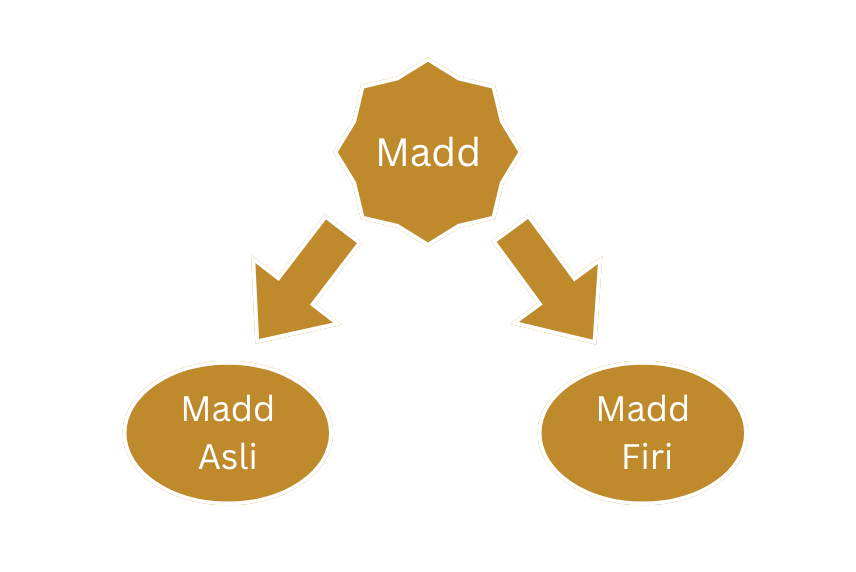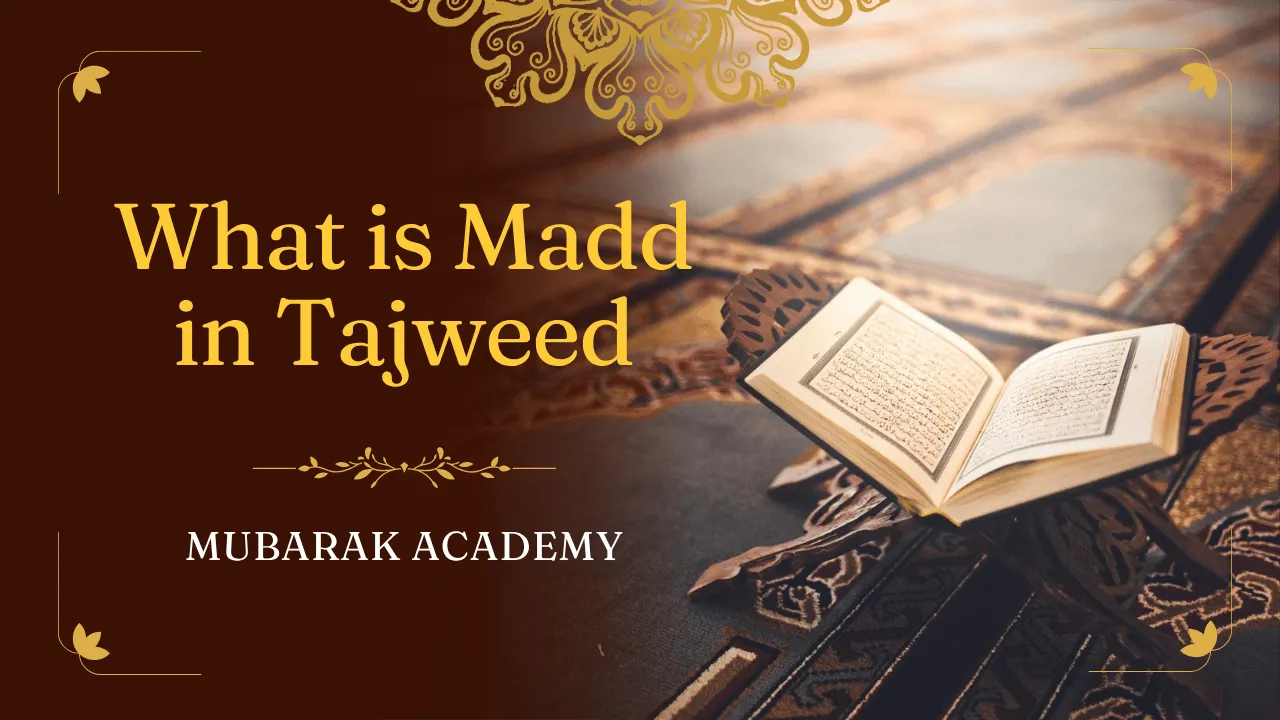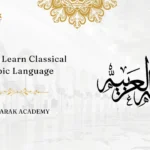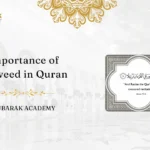For sure, you have heard a reciter beautifully stretch and stress certain words while reciting the Quran. Every sound, pause, and elongation in the Quran is intentionally designed to reflect the deep meaning of the sacred text.
Today, we will learn one of the most important features that shapes the beautiful recitation of the Quran: Madd. What is madd in tajweed, its letters, rules, types, and how to practice it correctly? We will simply clear up all of that and more in this blog.
What Is Madd in Tajweed?
Simply Madd refers to the elongation of long Arabic vowels, which are “ا، ي، و”, and it’s crucial for Quranic recitation. So, you should extend the pronunciation of these letters for a specific duration, as outlined in the rules mentioned below.
Madd in Quran Examples
As we explained before, what is Madd in tajweed, saying it’s stretching the sounds of the three letters of Madd “ ا، و، ي”.
They are collected in the Arabic word نُوحِيهَا. Three letters of Madd follow some rules to be pronounced correctly, which means that none of these letters can be stretched except in the presence of some conditions.
The Main 4 Madd Letters Rules
Rules of Madd in Tajweed are clear; they can be stuck in your mind by memorizing the word “نُوحِيهَا” that simply clarifies the conditions of Madd. Here they are:
- The Madd letters must be without Harakah: Fatha, Dummah, or Kasrah. They should be preceded by one of the 3 Harakah that is homogenous with each letter of them:
- The Madd letter must be silent without any vowel on it, stretching the letter before it.
- The letter before the Madd letter must have the mentioned Harakat, or the Madd will not be applicable. For instance, if the Madd letter is Waaw (و), and the letter before it is the Fatha Harakah instead of dammah, so this Madd will not be applied.
- Whenever the Madd conditions are present, we apply the Madd:
- Alif madd: When a Fatha comes before alif, we stretch it for two counts.
- Wow madd: When a damma comes before wow, we stretach it for two counts.
- Ya madd: When a kasra comes before ya, we stretch it for two counts.
Types of Madd in Tajweed
Madd types are categorized into two major types, which are:
- Madd Asli (Natural Madd)
- Madd Fari (Secondary Madd)

1. Madd Asli (مد أصلي)
Madd Asli, also called Madd Tabeei, is the natural form of elongation in Tajweed. It typically occurs when one of the Madd letters “ ا، و، ي” is not followed by a Sukoon (◌ْ) or a Hamzah (ء). In this case, we should prolong the Madd letter for just two counts or two Harakaat.
Madd asli examples in quran:
- قَالَ
- يُوْسُفُ
- بُوْرِك
- يُوْصِيْكُمُ
- خَالِدِيْنَ
2. Madd Fari (مد فرعي)
Madd Fari is also categorized into two sections:
Madd Fari Due to Hamze
When Madd is followed by Hamza, Hamza can be in the same word or the next words:
- Wajib Mutasl: A letter of Madd followed by Hamze in the same word. Elongated 4,5,6 Harakat.
- Jaaiz Munfasil: A letter of Madd followed by Hamza in the next word. we can elongate 4,5,6 Harakat.
Madd Fari Due to Sukoon
When Madd is followed by Sukoon:
- Laazim: It’s caused by an original Sukoon after a madd letter. Elongated 6 Harakat. Under the umbrella of Madd Fari Due to Sukoon laazim, there are two types “Harfee, Kalemee.”
- Arid li Sukoon: When the Madd letter is followed by Sukoon that is not original in a word. Elongated 2, 4, 6 Harakat.
Common Errors When Practicing
Learning what is Madd in Tajweed is only the first step toward perfecting Quranic recitation.
Consistent practice is key, and making mistakes is a natural part of the learning process. However, recognizing and correcting these common errors early can significantly improve your accuracy and fluency.
1. Skipping Madd Letters:
Ignoring Madd letters during recitation leads to incorrect elongation. This mistake can alter pronunciation and even change the meaning of the words.
2. Over-Elongating Vowel Sounds:
Stretching the vowel sounds for more than two Harakahs causes trouble with the natural flow of recitation and alters the intended rhythm of the Quranic verse.
3. Under-Elongating Madd Sounds:
Contrary to the prior mistake, you can miss elongating the vowel sounds for the full two Harakat, which makes a rushed sound and affects the whole recitation.
4. Confusing Different Types of Madd:
Mixing up Madd types that require varying lengths of elongation can lead to inconsistencies. Understanding each Madd type and the rules of Madd in Tajweed is essential for proper Tajweed.
Importance of Learning Madd in Tajweed
When this question, “what is Madd in Tajweed” arises, you should be aware that Madd is not just to beautify your voice while reciting the Quran. Madd in Quranic recitation is crucial for a lot of reasons, such as:
1. Maintaining the Quranic Text As It Was Revealed
The original text of the Quran that was revealed to our Prophet Muhammad (peace be upon him) has precise elongations to express the right meaning and the divine message.
2. Proper Reading
The proper reading of the Quran can be achieved by the right application of Tajweed rules, like Madd rules that improve clarity and perfect pronunciation.
3. Adjusting the Rhythm
This elongation of the vowels adds a melodious flow to the recitation. This is one of the secrets of our reciters’ fabulous recitations: adjusting the rules of Madd, which contributes to the rhythm of Quranic tilawat.
4. Improving the Spiritual Experience and Feeling the Meaning
Applying Madd correctly gives you an opportunity to feel the meaning and ponder its beauty, improving the spiritual experience of reciting and listening to the Quran and its impact on your soul.
5. Differentiating Between Qira’at
We have different styles of recitation, which are called “Qira’at.” They are different in the application of Madd rules. Learning these rules helps people grasp and appreciate the diversity of Quranic recitation.
Learn Tajweed Online with Certified Quran Tutors
There is no shortcut to mastering Tajweed! However, your journey can be much easier with qualified teachers and structured Tajweed books and resources that facilitate the success pathway.
If you’re eager to perfect your recitation and master the rules of Madd and other Tajweed principles, join the Tajweed Rules Course at Mubarak Academy today. Mubarak Academy ensures that every student recites the Quran beautifully, accurately, and with a full understanding of each rule.
Conclusion
Now that you understand what is Madd in Tajweed and its importance in Quranic recitation, it’s time to take the first step in Learning and applying the rules of Madd.
Start your journey today with Mubarak Academy, a trusted online Quran academy that helps students learn Tajweed correctly, confidently, and effortlessly. With expert guidance and structured lessons, you’ll gain the skills and spiritual connection needed to recite the Quran beautifully and meaningfully.
Frequently Asked Questions
1. What is Madd in Arabic Tajweed?
In Arabic Tajweed, Madd (المدّ) refers to the elongation or stretching of a vowel sound during Quranic recitation.
2. How long is Madd Al-Asli?
Madd Al-Asli is always two harakats long – the time to open two fingers sequentially.
3. Why is it called Madd Asli or Madd Tabee‘ee?
Because it has no external cause and is the natural vowel length; also called Madd Tabee‘ee.
4. What does Madd Asli include?
Madd Asli appears in several cases, such as:
- The five letters that appear at the start of some surahs (e.g., حَيٌّ طَهُر).
- Words like قَالَ, أَعْمَالُهُمْ, تُبْصِرُونَ, يُوسُفُ, and خَالِدِينَ.
- Alif changed from tanween with fatḥah, as in عَلِيمًا and حَكِيمًا.
- Alif with a small sukoon mark, as seen in أَنَا and لَكِنَّا in Surah Al-Kahf.
5. What causes Madd Faree‘?
here are two main causes:
- Incorporeal cause – related to meaning; rare and not used in the Hafs narration from Al-Shatibiyyah.
- Lexical cause – related to a specific letter that lengthens the sound more than Madd Asli.
6. What are the rules of Madd Faree‘?
Madd Faree follows three main rules depending on its type:
- Compulsory Madd (Madd Mutassil): Must be prolonged more than Madd Asli – four to six harakats.
- Permissible Madd (Madd Munfasil, Madd ‘Arid Lis-Sukoon, Madd Badal): Can be shortened or extended.
- Absolutely Necessary Madd (Madd Lazim): Always six harakats in all recitations.





Junior
17 Oct, 2025This was the best school that I’ve ever tried when it came to learning the Arabic language the teachers make sure you know the correct way of pronouncing each word/ letter these teachers go above and beyond very patient and courteous. I would recommend to anyone that’s trying to learn Arabic or get closer to their faith
ahmed aziz
19 Oct, 2025mashaa Allah This is one of the best academies I have dealt with. The teachers are professional and fun, and my children are happy.
Junior
19 Oct, 2025This has been by far the best experience I’ve ever had when it comes to learning the Arabic language. The teachers take their time to explain and ensure that you are learning the correct grammar and pronunciation. I’ve even enrolled my children to the school as it’s so affordable. If you are looking for a good school then look no further here is where you wanna be .